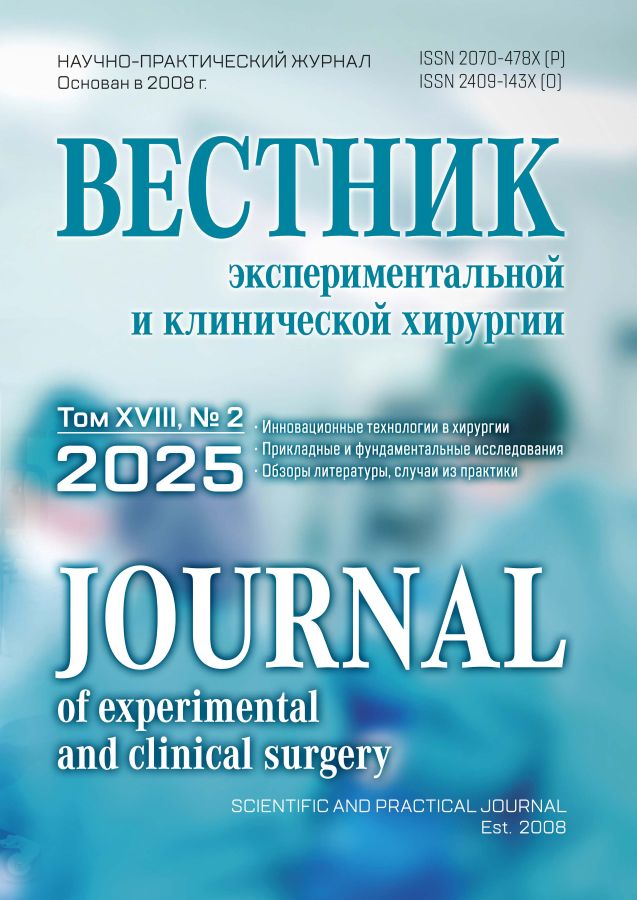A New Technique for Spleen Resection
- Authors: Pikin I.Y.1, Kagan I.I.2, Nuzova O.B.2, Fayzulina R.R.2
-
Affiliations:
- Pirogov City Clinical Hospital
- Orenburg State Medical University
- Issue: Vol 18, No 2 (2025)
- Pages: 98-104
- Section: Original articles
- URL: https://vestnik-surgery.com/journal/article/view/1871
- DOI: https://doi.org/10.18499/2070-478X-2025-18-2-98-104
- ID: 1871
Cite item
Abstract
Introduction. Currently, the concept of preserving the spleen functions is considered generally acknowledged. Among organ-preserving surgeries involving the spleen, resection of the damaged part of the organ is worth noting. Notably, the use of various resection techniques is limited in some cases due to inefficiency and technical complexity.
The aim of the study was to develop experimentally a novel technique for polar wedge resection of the spleen.
Materials and methods. The study involved 29 human cadavers, 54 rabbits (83 items totally). Five of 29 unfixed spleen sections were studied using histotopographic approach, and 24 were subjected to wedge resection of the poles. An option for wedge resection of the spleen was developed in two versions: ligature and adhesive. Each option was tested on 12 sections of the cadaveric spleen. It was found that the optimal angles for performing resection are 45° and 60°. In the first version of the developed technique (ligature), double-row through U-shaped sutures were used; after the edges were brought together, nodal microsurgical sutures were applied to the spleen capsule. The second version of the developed technique (adhesive) included the use of medical surgical glue "Sulfacrylate" and a single-row nodal microsurgical suture on the capsule. The first version of the new technology was used in the rabbits in the first experimental series, and the second version was used in the laboratory animals in the second experimental series. In the rabbits of the third (control) series, the edges of the spleen pole were sutured with a continuous suture with fixation of the greater omentum. The material obtained after experiments on cadavers and laboratory animals was sent for histotopographical examination.
Results. Under both variants of the new technique, histotopograms of the cadaveric spleen poles demonstrated a juxtaposition of histologically homogeneous layers, and the capsule was defined as a continuous line. Reliable hemostasis was achieved in animals of all series. Histotopograms of the spleen poles of rabbits of the experimental series obtained on the 7th, 14th, and 21st days showed a juxtaposition of histologically homogeneous layers, and the capsule was defined as a continuous line. No postoperative complications were observed. In rabbits of the control series, histotopograms showed no juxtaposition of histologically homogeneous layers on the 7th, 14th, and 21st days after surgery, and capsule deformation was observed. Purulent splenic inflammation in the form of a micro-abscess was observed in 2 of 18 (11.1%) rabbits of this series.
Conclusion. A new technology of the spleen resection has been developed in two variants. The use of the new resection technique ensures reliable hemostasis, precise contact of the surfaces being connected, prevents parenchyma cutting, and allows preserving almost the entire functionally active parenchyma.
Keywords
Full Text
About the authors
Ilya Yu. Pikin
Pirogov City Clinical Hospital
Author for correspondence.
Email: ilya.pikin.1994@mail.ru
Surgeon
Russian Federation, OrenburgIlya I. Kagan
Orenburg State Medical University
Email: kaganil@mail.ru
M.D., Honored Scientist of the Russian Federation, Professor at the Mikhailov Department of Operative Surgery and Clinical Anatomy
Russian Federation, OrenburgOlga B. Nuzova
Orenburg State Medical University
Email: nuzova_27@mail.ru
M.D., Professor at the Department of Faculty Surgery
Russian Federation, OrenburgRegina R. Fayzulina
Orenburg State Medical University
Email: reginafaizulina@yandex.ru
Ph.D., Associate Professor at the Department of Faculty Surgery
Russian Federation, OrenburgReferences
- Podkamenev VV, Pikalo IA. The concept of spontaneous hemostasis in spleen injury in children. Medicinskij vestnik Severnogo Kavkaza. 2016; 3: 409-413. (in Russ.)
- Kagan II, Nuzova OB, Pikin IYu. Organ-Preserving Surgeries on the Spleen: Evolution of Concepts. Journal of experimental and clinical surgery. 2023; 16: 2: 180-185. doi: 10.18499/2070-478X-2023-16-2-180-185. (in Russ.)
- Ionkin DA, Stepanova YuA, Alimurzaeva MZ. Spleen resection using radio frequency ablation. Clinical and Experimental Surgery. Petrovsky Journal. 2024; 12 (3): 40–7. DOI: org/10.33029/2308-1198-2024-12-3-40-47 (in Russ.)
- Chernuhin AA, Odishelashvili LG. Organpreserving operations in the surgical treatment of spleen injuries. Novaja nauka: ot idei k rezul'tatu. 2017; 2: 2: 44-46. (in Russ.)
- Autlev KM, Kruchinin EV, Aliev VF, Yahyaev EZ, Zhabelov RO, Autlev MK, Kozlov MV, Mokin EA, Alekberov RI, Lukashenok AV, Akhmetianov MA. A case of laparoscopic resection of a simple spleen cyst. Ural'skij medicinskij zhurnal. 2019; 03 (171): 89–91. doi: 10.25694/URMJ.2019.03.29 (in Russ.)
- Alkhasov AB, Komina EI, Ratnikov SA, Romanova EA, Savelieva MS, Kyarimov IA. Isolated lymphangioma of the spleen. Pirogov Russian Surgical Journal. 2023; 3: 77–82. doi: 10.17116/hirurgia 202303177. (in Russ.)
- Shapkin YuG, Maslyakov VV. Typical complications in the longterm period in patients operated for trauma of the spleen. Vestnik khirurgii imeni I. I. Grekova. 2009; 3: С. 39–43. (in Russ.)
- Sabatino AD, Carsetti R, Corazza GR. Post-splenectomy and hyposplenic states Sabatino. Lancet. 2011; 378: 2: 86–97. doi: 10.1016/S0140-6736(10)61493-6
- Бордуновский В.Н. Сберегательная хирургия при повреждениях и очаговых образованиях селезенки. Хирургия. 1999; 6: 38 – 42.
- Zywicka B, Rybak Z, Janeczek M, Czerski A, Bujok J, Szymonowicz M, Dobrzynski M, Korczynski M, Swiderski J. Comparison of A 1940 nm Thulium-Doped Fiber Laser and A 1470 nm Diode Laser for Cutting Efficacy and Hemostasis in A Pig Model of Spleen Surgery. Materials. 2020; 13: 5: 1167. DOI.org/10.3390/ma13051167
- Odishelashvili GD, Pakhnov DV, Odishelashvili NG. Methods to stop bleeding in spleen injuries depending on the nature of its damage in the experiment. Experimental and Clinical Gastroenterology. 2022;(4):131-137. DOI.org/10.31146/1682-8658-ecg-200-4-131-137 (In Russ.)
- Soldatova DS, Bezhin AI., Ishunina TA. Efficacy of the New Hemostatic Composite Based on Sodium Gel Carboxymethylcellulose and Aminocaproic Acid: Experimental Application after Partial Splenectomy in Rats. Journal of experimental and clinical surgery. 2020; 13: 4: 319-325. doi: 10.18499/2070-478X-2020-13-4-319-325. (in Russ.)
- Kagan II, Tretyakov AA. Mikrokhirurgicheskie tekhnologii v abdominal'noi khirurgii. M.: GEOTAR-Media. 2016; 192.(in Russ.)
- Demina NB, Chernova LV, Kozlova ZhM. Application of adhesive compositions in surgery. Pirogov Russian Journal of Surgery. 2019;(3):129-134.https://DOI.org/10.17116/hirurgia2019031129. (in Russ.)
- Marchenko VT, Prutov NN, Tolstikov GA, Tolstikov AG. Meditsinskii klei «Sul'fakrilat» antibakterial'naya protivovospalitel'naya kleevaya kompozitsiya: rukovodstvo dlya primeneniya v khirurgicheskikh otraslyakh. Novosibirsk. 2005; 80. (in Russ.)
Supplementary files















